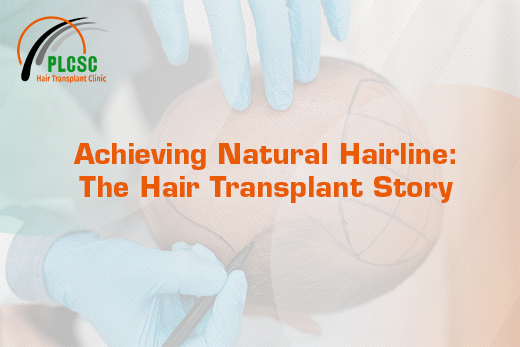TABLE OF CONTENTS
- Understanding the Nuances of Natural Hairline.
- 1. The Anatomy of a Natural Hairline:
- 2. Mimicking Nature Hair Angle and Direction:
- 3. Density Considerations for Realism:
“Will it look natural?”, “What if it gets messed up? “would become a laughing stock for people!?” WAIT! Hold your thoughts! We get how your concerns about natural-looking results may overshadow the desire for a hair transplant, but for us, it’s not merely a cosmetic pursuit—it’s a restoration of self-esteem!
So let’s explore how Hair transplants can contribute to achieving a natural-looking hairline.
UNDERSTANDING THE NUANCES OF NATURAL HAIRLINE.
The fundamental objective of a hair transplant is achieving a natural-looking hairline, a complex task requiring skill, communication, and preparation. Ensuring the transplanted hair blends seamlessly with the existing hair involves more than just adding more hair. Let’s discuss this in detail, shall we?
Among the many elements that dictate the result of a hair transplant, the main ones are –
- Method used
- Skills of the doctor
- Quality of available follicles and level of baldness
- Post-op care
The two methods majorly used in hair transplants are Follicular Unit Transplantation (FUT) and Follicular Unit Extraction (FUE).
FUT involves surgically removing a strip of skin containing hair follicles from the donor area, dissected into individual follicular units for transplantation. This method is favored by plastic surgeons and is considered the gold standard for its efficiency in minimizing wastage and transection and producing a large number of grafts in a single surgery.
- Donor Area Selection: The surgeon carefully selects the donor area to ensure that the hair follicles are genetically programmed to resist the effects of male pattern baldness. This ensures that the transplanted hair will be more likely to retain its characteristics in the recipient area.
- Strip Harvesting: In FUT, a strip of skin is surgically removed from the donor area. The size of the strip can vary depending on the patient’s specific needs and the surgeon’s judgment. The incision is typically closed with stitches or staples, leaving a linear scar.
- Follicular Unit Dissection: The harvested strip is then carefully dissected under a microscope to separate it into individual follicular units. Follicular units are natural groupings of hair follicles that occur in the scalp. These units may contain one to four (or sometimes more) hair follicles.
- Recipient Site Preparation: While the grafts are being prepared, the recipient area (bald or thinning region) is prepared for transplantation. Tiny incisions are made where the grafts will be placed, taking into consideration the natural hair growth pattern and aesthetic considerations.
- Graft Placement: The dissected follicular units are then meticulously transplanted into the recipient site. The surgeon pays careful attention to the angle, direction, and density to achieve a natural-looking result.
- Healing and Recovery: After the surgery, the donor area is sutured or stapled, and the recipient area is left to heal. Patients are provided with post-operative care instructions to ensure proper healing and minimize the risk of complications.
FUE involves the extraction of individual hair follicles directly from the donor area using a micro-punch tool, implanting them into the recipient area, allowing for precise control over placement, but potentially missing sebaceous glands, impacting hair health.
Apart from the method, the volume, structure and quality of hair in the donor area, as well as the level of baldness of the patients also affect the procedure. Insufficient supply may yield unsatisfying results. Not just that, successful transplants also depend on post-operative care. Adequate attention to aftercare promotes a seamless and natural-looking result.
However! Above all stands the skill of the surgeon. Analysing an individual’s features and strategizing how to provide satisfactory results is the art bestowed to a few. Major factors contributing to a natural-looking hairline are:-
Natural Hairline
1. THE ANATOMY OF A NATURAL HAIRLINE:
A natural-looking hairline is crafted with precision, taking into account facial symmetry, forehead shape, and temporal points. Surgeons aim to achieve an irregular, staggered pattern that emulates the randomness of natural hair growth. Strategic placement of grafts is essential to achieve a natural-looking hairline.
2. MIMICKING NATURE HAIR ANGLE AND DIRECTION:
Success lies in mimicking the natural angle and direction of existing hair. This ensures seamless integration of transplanted hair with the surrounding natural hair.
3. DENSITY CONSIDERATIONS FOR REALISM:
Balancing density is an art in itself; an overly dense hairline can appear unnatural. Gradual increases in density from the front to the back contribute to a harmonious and authentic outcome.
In conclusion, achieving a natural-looking hairline requires the skilled hands of surgeons with a keen artistic eye. At the forefront of excellence in hair transplantation is the renowned clinic, PLCSC. Trust PLCSC for unparalleled expertise in crafting a seamless and natural transition for your hair restoration journey
Embark on your journey to a natural-looking hairline with PLCSC’s expertise—where skill meets art.
For more details, visit Our Website


Leave a Reply